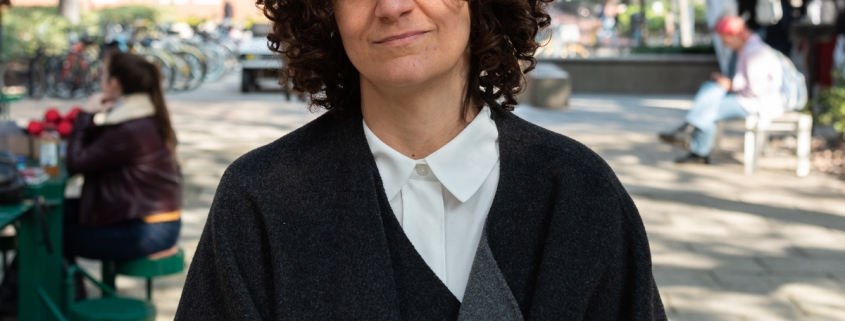Architecture professor invents wearable garden

Arrousiak Gabrielian created the vest as a fellow at the American Academy in Rome. It is currently part of the “Human (un)limited“ exhibit (Vincent Leo | Daily Trojan) .
Aroussiak Gabrielian, an assistant professor at the School of Architecture, has created the first wearable garden, which comprises a vest that can grow a variety of herbs and vegetables using human waste as a fertilizer. Gabrielian is the co-founder and director of design at Foreground Design Agency and developed the vest as a fellow at the American Academy in Rome. The vest is currently part of a joint exhibition entitled “Human (un)limited” by Hyundai Motorstudio and Ars Electronica in Beijing.
In a CBC Radio interview, Gabrielian described how the wearable garden works. The seeds are set on a layer of moisture retention fabric. Left uncovered, it takes around two weeks for the base material, which are microgreens, to grow.
The wearable garden falls within the area of agriculture called hydroponics, which, according to Grant Calderwood, a microgreens collaborator on the project and managing member of Hortus Research, is the growing of plants in water and nutrients. The vest also captures urine from the wearer via catheter to be filtered through a process called forward osmosis, which was developed by NASA and is used in space to convert urine into portable drinking water and eventually delivered to the crops as irrigation.
Gabrielian described wearing the vest as a multi-sensory feeling because of its weight and the way it is built. The vest has to be watered and serves as an insulator because of the amount of plant material that covers it. It also has a distinct smell of vegetables, such as cabbages and radishes, that are grown on it.
“I think, you know, what is really special about Arrousiak’s project, is that it captures the imagination,” said Calderwood, who is also a Yale University lecturer on sustainability. “Like there’s the level of excitement when people see the jacket up close, growing with food on it.”
The inspiration for the vest first came to Gabrielian when she began breastfeeding her first daughter. Gabrielian was also influenced by Rosi Braidotti’s book “The Posthuman,” which poses the question, “What would a geo-centred subject look like?”
“These ideas, of cooperation and collaboration with the more-than-human world, along with the experience post-birth, triggered the idea for the project: to use the human body and systems to feed more than just our kin,” Gabrielian wrote in an email to the Daily Trojan.
Gabrielian said climate change is either described at the planetary scale or the microscopic scale, which both take place outside of the realm that humans respond or relate to.
“I feel like the issues are either too big for us to really grasp at the human scale or too small,” Gabrielian said. “And so, in my work what I’ve tried to do is kind of tap into those and bring those to the scale of the body to actually have you have a palpable experience of either.”
While in Rome, Gabrielian worked with a vast team to develop the project, including a local fashion designer, a seamstress and Calderwood as well as Chris Behr, a chef with the Rome Sustainable Food Project and Alison Hirsch, a School of Architecture associate professor and Gabrielian’s design partner.
The time in Rome was spent conducting plant tests, hunting down material, working with fashion designers and collaborating with the Rome Sustainable Food Project to get the vest ready.
“It was a wonderful adventure and the project has continued to develop under Aroussiak’s leadership since we’ve been back,” Hirsch wrote in an email to the Daily Trojan.
The wearable garden has received much media attention, some of which frames the wearable garden as a commodity.
“Even the way it’s been framed in some of the news articles is that it’s a thing,” Gabrielian said. “It’s like a product … It’s been kind of bizarre to see the kind of life it’s taken in the media.”
The wearable garden is one prototype out of three in Gabrielian’s dissertation doctoral work, which is currently being developed and will have three chapters with three associated prototypes. Gabrielian said that “all of the work tries to interrogate the position of the human in our environmental future and what they will be.”
Gabrielian said there are several possible avenues for the project in the future, including quantifying the health effects, quantifying carbon outputs or using the mechanical element of the project to equip the vest with sensors that could regulate the moisture content and access to sunlight. Another route is automating the vest so that it’s self-sustaining.
“There is that moment where it’s, you know, it was meant to be a speculative project, but all these people are interested in the real thing,” Gabrielian said. “So there’s this weird kind of dilemma, you know? Do I go there? Do I make it more real? Or do I let it kind of live in this weird in-between space? That, I haven’t yet kind of served for.”

